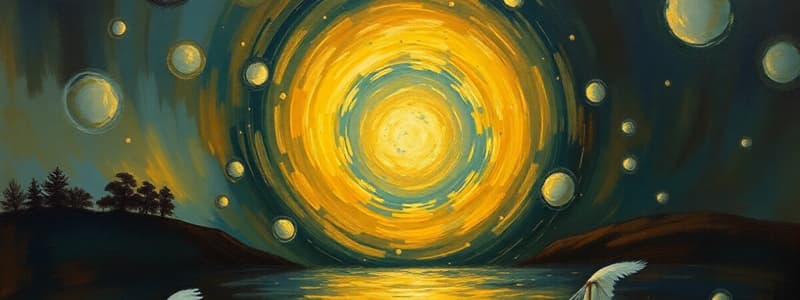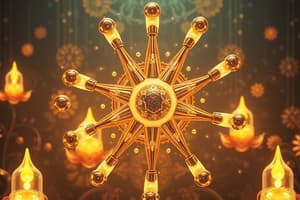Podcast
Questions and Answers
What particles are found in the atomic nucleus?
What particles are found in the atomic nucleus?
- Protons and electrons
- Protons and neutrons (correct)
- Electrons and muons
- Neutrons and electrons
What determines the atomic number of an element?
What determines the atomic number of an element?
- The number of stable isotopes
- The total number of neutrons
- The total number of protons (correct)
- The sum of protons and neutrons
Which force holds the protons and neutrons together in the nucleus?
Which force holds the protons and neutrons together in the nucleus?
- Weak nuclear force
- Electromagnetic force
- Strong nuclear force (correct)
- Gravitational force
What does the mass number of an atom represent?
What does the mass number of an atom represent?
What is an isotope?
What is an isotope?
How is the atomic mass of an element calculated?
How is the atomic mass of an element calculated?
Why are neutrons important in the atomic nucleus?
Why are neutrons important in the atomic nucleus?
What is the charge of a proton?
What is the charge of a proton?
Which of the following statements is true about stable isotopes?
Which of the following statements is true about stable isotopes?
How can mass number be calculated?
How can mass number be calculated?
What is carbon-14 primarily used for?
What is carbon-14 primarily used for?
What occurs during nuclear fission?
What occurs during nuclear fission?
Which process powers the sun?
Which process powers the sun?
What did Rutherford's Gold Foil Experiment demonstrate?
What did Rutherford's Gold Foil Experiment demonstrate?
In beta decay, what happens to a neutron?
In beta decay, what happens to a neutron?
Which force is primarily responsible for holding protons and neutrons together in the nucleus?
Which force is primarily responsible for holding protons and neutrons together in the nucleus?
What is one application of radioactive isotopes in medicine?
What is one application of radioactive isotopes in medicine?
Which statement is true regarding alpha decay?
Which statement is true regarding alpha decay?
What is the main focus of modern nuclear models?
What is the main focus of modern nuclear models?
What does the Bohr model describe?
What does the Bohr model describe?
Flashcards are hidden until you start studying
Study Notes
Atomic Nucleus Composition
- The atomic nucleus is composed of protons and neutrons.
- Protons carry a positive charge and determine the element.
- Neutrons are neutral particles that contribute to the atomic mass and help stabilize the nucleus.
- Protons and neutrons are held together by the strong nuclear force, one of the four fundamental forces of nature.
Atomic Number and Mass Number
- The atomic number (Z) represents the number of protons in the nucleus, defining the element.
- The mass number (A) is the total number of protons and neutrons, indicating the atomic mass.
- The mass number can be calculated as A = Z + N, where N is the number of neutrons.
Isotopes
- Isotopes of an element have the same number of protons but different numbers of neutrons.
- Stable isotopes do not undergo radioactive decay.
- Radioactive isotopes, also known as radioisotopes, are unstable and decay over time, releasing radiation.
- Isotopes have various applications including medical imaging, dating fossils and archaeological artifacts, and studying chemical processes.
Nuclear Reactions
- Nuclear reactions involve changes in the nucleus, potentially creating new elements or isotopes.
- Nuclear fission: a heavy nucleus splits into lighter nuclei, releasing energy.
- Nuclear fusion: two light nuclei combine to form a heavier nucleus, releasing energy.
- Alpha decay: an unstable nucleus emits an alpha particle (two protons and two neutrons)
- Beta decay: a neutron transforms into a proton (or vice versa) within the nucleus, emitting a beta particle (an electron or positron).
- Gamma decay: an excited nucleus emits high-energy photons (gamma rays)
The Nuclear Model of the Atom
- Rutherford's gold foil experiment led to the discovery of the atomic nucleus.
- The nuclear model of the atom describes a small, dense nucleus surrounded by orbiting electrons.
- Bohr's model introduced quantized electron orbits or energy levels.
Modern Understanding of the Nucleus
- Quantum mechanics describes particle behavior at the atomic and subatomic levels.
- The strong nuclear force, mediated by gluons, binds protons and neutrons together.
- Modern nuclear models include nuclear shell models and liquid drop models, explaining nuclear structure and stability.
Practical Implications
- Nuclear medicine uses radioactive isotopes for diagnosis and treatment.
- Nuclear reactors use fission reactions to generate electricity.
- Nuclear physics research contributes to our understanding of fundamental forces and particles.
Conclusion
- The atomic nucleus is a vital component of matter, influencing the structure and behavior of atoms.
- Understanding the nucleus provides insights into the nature of elements, chemical reactions, and nuclear science applications.
- This knowledge is essential for technological advancements, improving medical treatments, and exploring the fundamental principles of the universe.
Studying That Suits You
Use AI to generate personalized quizzes and flashcards to suit your learning preferences.




